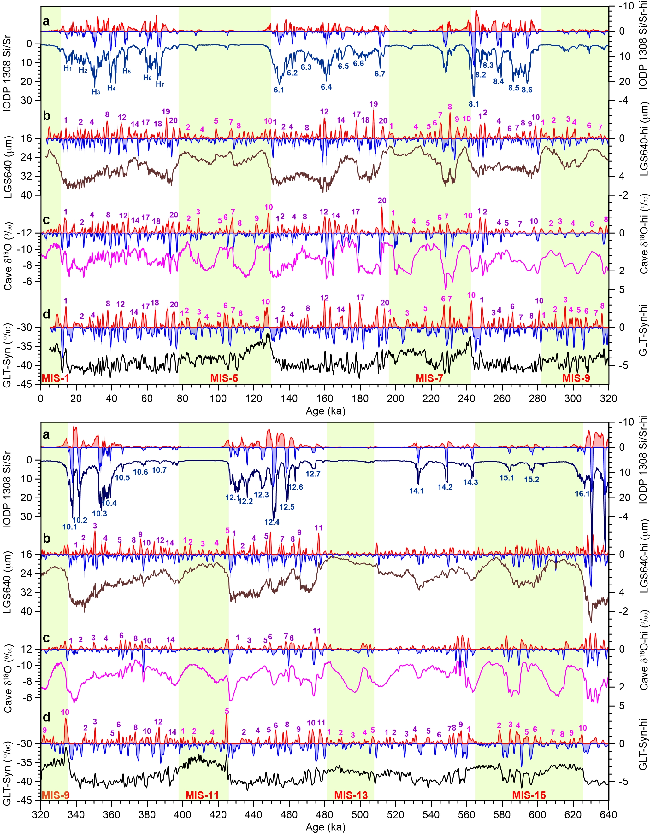Chinese loess and stalagmites are two classic terrestrial archives that have been intensively studied to reconstruct the characteristics and dynamics of orbital- and millennial-scale monsoon variability.
The loess records mainly exhibit significant glacial-interglacial fluctuations, and abrupt changes on millennia timescales spanning at least the last two glacial cycles. The stalagmites δ18O records demonstrate dominant precession-scale fluctuations superimposed by persistent rapid changes over the last six glacial cycles.
However, comparability between these two representative archives, in terms of both periodicities and abrupt event, remains contested due to chronological uncertainty and proxy complexity.
The loess deposits from the western and northern Chinese Loess Plateau (CLP) are unique in recording the orbital- and millennial-scale monsoon variability due to the high-sedimentation-rate and weak pedogenesis.
Recently, a joint research led by Prof. SUN Youbin from Institute of Earth Environment, Chinese Academy of Sciences, reported five high-sedimentation-rate loess records, including three loess cores retrieved at Jingyuan, Gulang, Linxia in the northwestern CLP and two loess profiles at Dingbian in the northern CLP and Mangshan in the southeastern CLP(Fig.1).
The high-resolution time series of grain-size and magnetic susceptibility was obtained to assess the characteristics and dynamics of orbital- and millennial-scale East Asian monsoon variability.

Fig. 1 Map showing locations of high-sedimentation-rate loess records in the CLP (Image by SUN, et)
Correlating loess grain size (a winter monsoon proxy) to speleothem δ18O (a summer monsoon proxy), they established a new speleothem-based chronology for Chinese loess-paleosol sequences over the past 640 ka. The synchronized loess grain-size records indicated that winter monsoon variability is spatially consistent on glacial-interglacial to millennial timescales, exhibiting distinctive precession- and millennial-scale changes similar to those of speleothem δ18O records (Fig.2).
Due to differences in sedimentation rate and pedogenesis, magnetic susceptibility variations over the CLP are spatially different. The magnetic susceptibility records from the central CLP exhibit significant glacial-interglacial fluctuations and remarkably increase in S5–1 (MIS 13) in the central CLP. However, magnetic susceptibility from the western CLP demonstrate precessional fluctuations within interglacial paleosol layers and significant increase in the magnetic susceptibility occurred in S4 or S3.

Fig. 2 Comparison of high-sedimentation-rate loess proxies (blue-grain size, red-magnetic susceptibility) with speleothem δ18O record (Image by SUN, et)
The mean-grain-size time series of three loess cores from western CLP is consistent on glacial-interglacial to millennial timescales oscillation, and thus can be interpolated at 0.2 ka and then averaged to generate a loess grain-size stack (LGS640) over the past 640 ka (Fig.3). The LGS640 stack can be regarded as a new reference for addressing orbital- and millennial-scale winter monsoon variability. Cross-spectral results of a loess grain-size stack with benthic oxygen isotope and orbital parameters reveal that ice volume has played a more dominant role than insolation in driving orbital-scale winter monsoon fluctuation.
Comparison of high-frequency (<9 kyr) components of the LGS640 stack and speleothem δ18O with the North Atlantic and ice-core records reveals that millennial-scale abrupt events are persistent and comparable during glacial periods. However, the magnitudes of abrupt climate events are quite different among these records during interglacials, implying that dynamics of abrupt climate changes are likely dissimilar under different glacial and interglacial boundary conditions.

Fig. 3 Correlation of abrupt climate events in terrestrial, marine and ice-core records (Image by SUN, et)
By integration and comparison of multiple records, the researchers indicate that Chinese loess has great potential in revealing characteristics and dynamics of millennial-scale monsoon variability. In-depth research about abrupt monsoon variability should focus on quantitatively disentangling the abruptness of temperature and precipitation changes and utilizing proxy-model comparison to provide a thorough dynamical understanding of co-evolution of orbital and millennial climate variability.
This work, published in Earth-Science Reviews, was funded by grants from the Chinese Academy of Sciences (No. XDB40000000) and the National Natural Science Foundation of China (No. 41525008).
Contact: Bai Jie, Institute of Earth Environment, Chinese Academy of Sciences, Xi'an, China. Email: baijie@ieecas.cn
 © 2015 Institute of Earth Environment,CAS
© 2015 Institute of Earth Environment,CAS Address:No. 97 Yanxiang Road, Xi'an 710061, Shaanxi, China

 Location :
Location :